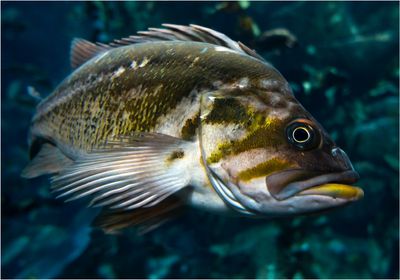ABOVE: Quillback rockfish (Sebastes maliger) can live for 90 years. © iStock.com, mirecca
Rockfish DNA may hold the secrets to a longer life, according to a study published yesterday (January 11) in Science Advances. Some rockfish species can live to be 200 years old, making them some of the longest-living animals on Earth. Researchers from Harvard Medical School and Boston Children’s Hospital combed through nearly two dozen rockfish (genus Sebates) genomes, finding genes associated with increased longevity. These genes, the researchers found, are also correlated with increased human longevity, and could one day help researchers better understand or even prevent age-related diseases.
“It’s a cool study,” says Peter Sudmant, an evolutionary geneticist at University of California, Berkeley who was not involved in the study. “It’s exciting to see groups working in these remarkable species that have these extreme, crazy lifespans.”
Study coauthor Stephen Treaster, a postdoc at Harvard and Boston Children’s Hospital, has always been interested in why certain species, like humans and rockfish, live for decades, while others, like mice, live just a few years. “If we look at the diseases that modern society still suffers from . . . like cancer, heart disease, Alzheimer’s. The greatest risk factor for these is not genetics or lifestyle. It’s really just age,” he says.
Treaster explains that rockfish are the perfect model to study why some species live longer than others. While many animal models live short, uniform lifespans, closely related species of rockfish live anywhere from 10 to 200 years. This incredible diversity in longevity came about in the span of just 8 million years—which is relatively quickly, evolutionarily speaking, he says. And a given species’ longevity is not closely aligned with other traits such as size, or with ecological variables—making it possible for researchers to isolate genes shared among long-lived rockfish lineages.
See “Secret to Reproductive Ants’ Longevity Revealed”
For the study, the researchers sequenced targeted regions of the genomes of 23 rockfish species, sourced from the Oregon State University Ichthyology collection and the Burke Museum, with lifespans ranging from 22 to 108 years. The sequencing included more than 285,000 coding elements, 118,000 conserved noncoding elements, and 2,500 ultraconserved noncoding elements, as well as nearly 300 microRNAs.
They then used the sequences to phylogenetically search for genes that evolved alongside changes in lifespan throughout the evolutionary history of rockfish. These analyses pointed to a network of genes involved in insulin signaling—a known regulator of longevity. “We are excited about this not because it was new, but because it showed the analysis was working,” Treaster says.
See “Different Genes Influence Lifespan in Male and Female Mice”
The team also found that a number of genes involved in flavonoid metabolism evolved alongside longevity. “This is the pathway we’re really excited about,” says Treaster, as “no one’s shown that [flavonoids] are involved in aging before.”
Flavonoids are plant compounds, present in our diets only in small amounts, that often have anti-inflammatory properties. While the researchers aren’t sure what role flavonoids might have in aging, Treaster says that these compounds resemble other compounds important to growth and development: steroids. “It’s easy to imagine how steroid hormones could influence broad life history traits like longevity, because they’re clearly entangled with” how quickly fish mature and age, he says.
Sudmant points out that in not sequencing the entire genome, it’s possible that the authors did not find longevity-related genes that changed very quickly over time, as this targeted approach would miss them in some species. While the authors acknowledge this possibility in their paper, they say their targeted sequencing approach helps overcome a lack of genomic resources, and write that the regions sequenced “represent conserved functionality that is more likely to inform and apply to longevity mechanisms outside the genus.”;
Indeed, the team went on to search for similar gene networks, for both insulin and flavonoids, in humans. By analyzing a large human genome sequencing database, they found that genetic variation in flavonoid metabolism genes was also linked to longer lifespans and survival in people. “Normally when you do human [genome-wide association studies] for longevity, you test the whole genome,” Treaster explains. “And when you do this for complicated traits, like longevity,” it’s hard to pick out statistically significant trends in so much data. “Testing the whole genome is statistically very demanding,” he says. But by first informing their analysis with the rockfish data, the team was able to look to search for a specific set of genes, making the job of finding genes correlated with longevity more straightforward.
Down the road, the researchers want to learn more about how insulin and flavonoid pathways influence aging. “We need to show a direct mechanism of how this is extending longevity and show that we can change it,” says Treaster. To do so, he and his team plan to genetically modify insulin and flavonoid metabolism genes in a more conventional model: zebrafish. “Once we have that information, then we can start thinking about making people live longer and healthier,” he says.

